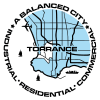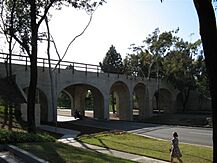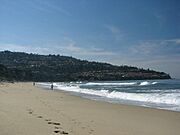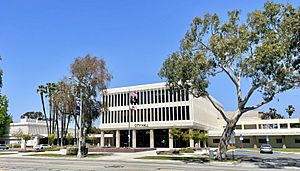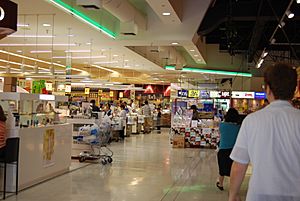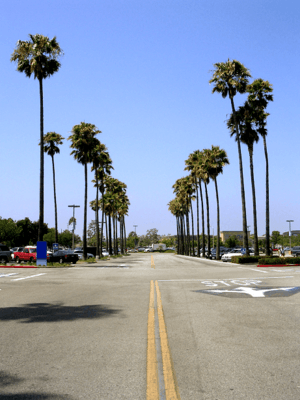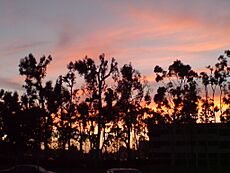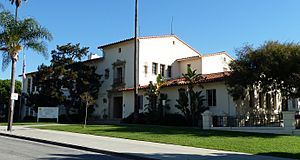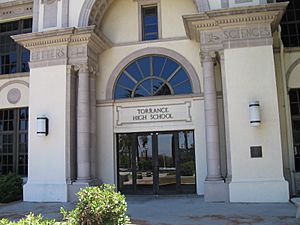Torrance, California facts for kids
Quick facts for kids
Torrance, California
|
|||||
|---|---|---|---|---|---|

Torrance Beach
|
|||||
|
|||||
| Motto(s):
"A Balanced City"
|
|||||
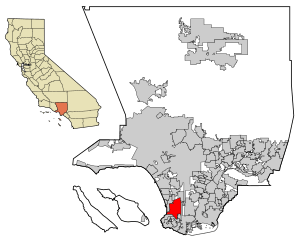
Location of Torrance in the County of Los Angeles
|
|||||
| Country | United States | ||||
| State | California | ||||
| County | Los Angeles | ||||
| Incorporated | May 12, 1921 | ||||
| Named for | Jared Sidney Torrance | ||||
| Government | |||||
| • Type | Council-manager | ||||
| Area | |||||
| • Total | 20.53 sq mi (53.18 km2) | ||||
| • Land | 20.50 sq mi (53.10 km2) | ||||
| • Water | 0.03 sq mi (0.08 km2) 0.37% | ||||
| Elevation | 89 ft (27 m) | ||||
| Population
(2020)
|
|||||
| • Total | 147,067 | ||||
| • Rank | 8th in Los Angeles County 41st in California 198th in the United States |
||||
| • Density | 7,163.5/sq mi (2,765.46/km2) | ||||
| Time zone | UTC−8 (Pacific) | ||||
| • Summer (DST) | UTC−7 (PDT) | ||||
| ZIP Codes |
90277, 90278, 90248, 90501, 90503–90510
|
||||
| Area codes | 310/424 | ||||
| FIPS code | 06-80000 | ||||
| GNIS feature IDs | 1652802, 2412087 | ||||
Torrance is a coastal city in the Los Angeles metropolitan area, located in southwest Los Angeles County, California, United States. The city is part of what is known as the South Bay region of the metropolitan area. A small section of the city, 1.5 miles (2.4 km), abuts the Pacific Ocean. Torrance has a moderate year-round climate with average rainfall of 12 inches (300 mm) per year. Torrance was incorporated in 1921, and at the 2020 census had a population of 147,067 residents. Torrance has a beachfront and has 30 parks located around the city. It is also the birthplace of the American Youth Soccer Organization (AYSO).
Contents
History
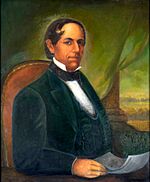
Pre-colonial era
For thousands of years, the area of Torrance was occupied by the Tongva Native Americans. The land that is now part of the City of Torrance and much of the modern South Bay was part of the extensive marshlands.
Spanish and Mexican eras
In 1784, the Spanish Crown deeded Rancho San Pedro (including present-day Torrance), a tract of over 75,000 acres (300 km2) in the province of Las Californias of New Spain, to soldier Juan José Domínguez. It was later divided in 1846, with Governor Pío Pico granting Rancho de los Palos Verdes to José Loreto and Juan Capistrano Sepulveda in the Alta California territory of independent Mexico.
Modern Era
In the early 1900s, real estate developer Jared Sidney Torrance and other investors saw the value of creating a mixed industrial–residential community south of Los Angeles. They purchased part of an old Spanish land grant and hired landscape architect Frederick Law Olmsted Jr. to design a planned community. The resulting town was founded in October 1912 and named after Torrance. The city of Torrance was formally incorporated in May 1921, the townsite initially being bounded by Western Avenue on the east, Del Amo Boulevard on the north, Crenshaw Boulevard on the west, and on the south by Plaza del Amo east of where it meets Carson Street, and by Carson Street west of where it meets Plaza del Amo.
The first residential avenue created in Torrance was Gramercy and the second avenue was Andreo. Many of the houses on these avenues reached the centennial mark in 2012. Both avenues are located in the area referred to as Old Torrance. This section of Torrance is under review to be classified as a historical district. Some of the early civic and residential buildings were designed by the renowned and innovative Southern California architect Irving Gill, in his distinctive combining of Mission Revival and early Modernist architecture.
Historic Olmstead District
Torrance was planned as a new prototype of a balanced industrial city based on the principles of the Garden City Movement. The original tract developed by the Olmstead Brothers consists of 109 city blocks divided into three sub-districts: residential, commercial, and industrial. The plan is most notable for its axial landscaped downtown commercial neighborhood aligned to have a view of Mount San Antonio in the San Gabriel Mountains. The Olmsted Tract includes a number of buildings designed by the noted Southern California Architect Irving Gill, including the original train depot.
The footprint of the downtown neighborhood, now called Old Torrance, was designed on a diagonal to allow the trade breezes coming from the Pacific Ocean to keep the air clean from industrial pollution for the residential and commercial neighborhoods. The industrial sections of the city were placed on the eastern side of the original tract.
Public transportation played a key role in the founding of Torrance. The Pacific Electric Red Car connected downtown Los Angeles to the new development of downtown Torrance. Designed in 1912 by Irving Gill, the terminus depot of the Red Car line was designed in a Spanish revival style popularized during this era. In May 1913, the Pacific Electric Railroad Bridge was built. Often called the "El Prado Bridge", it further expanded the industrial heart of the South Bay. The concrete double-tracked arch bridge was the Pacific Electric Railway's first interurban line that connected north–south to San Pedro via the Gardena Line. The bridge was used for transporting freight and commuting workers to Torrance factories. The Red Car line connected under the bridge as it connected to the train depot located on Cabrillo Avenue. The bridge no longer carries any rail cars, with Pacific Electric closing the Red Car line to Torrance in the 1940s. The bridge became the city of Torrance's second entry in the National Register of Historic Places on July 13, 1989, and is used as a logo for the city's new wayfinding signage and city materials.
Geography
Torrance is a coastal community in southwestern Los Angeles County sharing the climate and geographical features common to the Greater Los Angeles area. Its boundaries are: Redondo Beach Boulevard and the cities of Lawndale and Gardena to the north; Western Avenue and the Harbor Gateway neighborhood of Los Angeles to the east; the Palos Verdes Hills with the cities of Lomita, Rolling Hills Estates and Palos Verdes Estates on the south; and the Pacific Ocean and the city of Redondo Beach to the west.
The western portion of Torrance is in ZIP Code 90277 which is a city of Redondo Beach postal address. It is about 20 miles (32 km) southwest of Downtown Los Angeles.
Torrance Beach lies between Redondo Beach and Malaga Cove on Santa Monica Bay. The southernmost stretch of Torrance Beach, on a cove at the northern end of the Palos Verdes peninsula, is known to locals as Rat Beach (Right After Torrance).
An urban wetland, the Madrona Marsh is a nature preserve on land once set for oil production and saved from development, with restoration projects enhancing the vital habitat for birds, wildlife, and native plants.
Climate
Torrance has a warm-summer Mediterranean climate (Köppen: Csb), bordering with a semi-arid climate (Bsk). The rainy season is November through March, as shown in the adjacent table. Summers tend to be warm but dry, despite Torrance's proximity to the coast. The Sunset Western Garden Book places most of Torrance in Zone 22, part of a basin area in Greater Los Angeles where cold air can pool -- hence the surprisingly chilly record low temperatures for each calendar month at the airport, which has risk of frost over six months. Milder microclimates are found upslope of the airport to the south (Zone 23 -- thermal belt) and in the western blocks bordering the beach communities and Palos Verdes Estates (Zone 24 -- marine influence dominant).
| Climate data for Torrance, California (Torrance Airport), 1991–2020 normals, extremes 1932–present | |||||||||||||
|---|---|---|---|---|---|---|---|---|---|---|---|---|---|
| Month | Jan | Feb | Mar | Apr | May | Jun | Jul | Aug | Sep | Oct | Nov | Dec | Year |
| Record high °F (°C) | 91 (33) |
92 (33) |
96 (36) |
104 (40) |
98 (37) |
102 (39) |
102 (39) |
101 (38) |
111 (44) |
106 (41) |
98 (37) |
94 (34) |
111 (44) |
| Mean maximum °F (°C) | 80.8 (27.1) |
79.6 (26.4) |
81.4 (27.4) |
84.6 (29.2) |
83.1 (28.4) |
82.7 (28.2) |
86.0 (30.0) |
87.3 (30.7) |
92.0 (33.3) |
90.2 (32.3) |
85.8 (29.9) |
77.5 (25.3) |
95.5 (35.3) |
| Mean daily maximum °F (°C) | 66.8 (19.3) |
66.4 (19.1) |
67.7 (19.8) |
70.2 (21.2) |
71.8 (22.1) |
73.9 (23.3) |
76.9 (24.9) |
78.1 (25.6) |
78.1 (25.6) |
75.7 (24.3) |
70.7 (21.5) |
66.1 (18.9) |
71.9 (22.2) |
| Daily mean °F (°C) | 56.9 (13.8) |
57.0 (13.9) |
58.8 (14.9) |
60.9 (16.1) |
63.6 (17.6) |
66.2 (19.0) |
69.4 (20.8) |
70.2 (21.2) |
69.5 (20.8) |
66.4 (19.1) |
60.7 (15.9) |
56.2 (13.4) |
63.0 (17.2) |
| Mean daily minimum °F (°C) | 47.0 (8.3) |
47.6 (8.7) |
49.8 (9.9) |
51.6 (10.9) |
55.4 (13.0) |
58.5 (14.7) |
61.8 (16.6) |
62.4 (16.9) |
60.9 (16.1) |
57.1 (13.9) |
50.7 (10.4) |
46.3 (7.9) |
54.1 (12.3) |
| Mean minimum °F (°C) | 37.7 (3.2) |
39.3 (4.1) |
42.1 (5.6) |
44.3 (6.8) |
48.9 (9.4) |
52.4 (11.3) |
55.4 (13.0) |
55.2 (12.9) |
54.4 (12.4) |
49.8 (9.9) |
42.1 (5.6) |
37.1 (2.8) |
34.8 (1.6) |
| Record low °F (°C) | 24 (−4) |
27 (−3) |
23 (−5) |
28 (−2) |
37 (3) |
36 (2) |
42 (6) |
44 (7) |
41 (5) |
33 (1) |
29 (−2) |
27 (−3) |
23 (−5) |
| Average precipitation inches (mm) | 3.36 (85) |
3.66 (93) |
1.98 (50) |
0.63 (16) |
0.26 (6.6) |
0.07 (1.8) |
0.06 (1.5) |
0.00 (0.00) |
0.09 (2.3) |
0.49 (12) |
0.80 (20) |
2.24 (57) |
13.64 (346) |
| Average precipitation days | 6.2 | 6.4 | 4.9 | 2.4 | 1.4 | 0.5 | 0.5 | 0.0 | 0.4 | 2.0 | 3.1 | 5.7 | 33.5 |
| Source 1: NOAA | |||||||||||||
| Source 2: National Weather Service | |||||||||||||
Demographics
| Historical population | |||
|---|---|---|---|
| Census | Pop. | %± | |
| 1930 | 7,271 | — | |
| 1940 | 9,950 | 36.8% | |
| 1950 | 22,241 | 123.5% | |
| 1960 | 100,991 | 354.1% | |
| 1970 | 134,968 | 33.6% | |
| 1980 | 129,881 | −3.8% | |
| 1990 | 133,107 | 2.5% | |
| 2000 | 137,946 | 3.6% | |
| 2010 | 145,438 | 5.4% | |
| 2020 | 147,067 | 1.1% | |
| U.S. Decennial Census | |||
2020 census
| Race / Ethnicity (NH = Non-Hispanic) | Pop 2000 | Pop 2010 | Pop 2020 | % 2000 | % 2010 | % 2020 |
|---|---|---|---|---|---|---|
| White alone (NH) | 72,234 | 61,591 | 51,913 | 52.36% | 42.35% | 35.30% |
| Black or African American alone (NH) | 2,911 | 3,740 | 4,781 | 2.11% | 2.57% | 3.25% |
| Native American or Alaska Native alone (NH) | 360 | 304 | 235 | 0.26% | 0.21% | 0.16% |
| Asian alone (NH) | 39,210 | 49,707 | 51,857 | 28.42% | 34.18% | 35.26% |
| Native Hawaiian or Pacific Islander alone (NH) | 434 | 473 | 523 | 0.31% | 0.33% | 0.36% |
| Other Race alone (NH) | 383 | 505 | 980 | 0.28% | 0.35% | 0.67% |
| Mixed race or Multiracial (NH) | 4,777 | 5,678 | 8,698 | 3.46% | 3.90% | 5.91% |
| Hispanic or Latino (any race) | 17,637 | 23,440 | 28,080 | 12.79% | 16.12% | 19.09% |
| Total | 137,946 | 145,438 | 147,067 | 100.00% | 100.00% | 100.00% |
2010
The 2010 United States Census reported that Torrance had a population of 145,438. The population density was 7,076.1 inhabitants per square mile (2,732.1/km2). The racial makeup of Torrance was 74,333 (51.1%) White (42.3% Non-Hispanic White), 50,240 (34.5%) Asian, 3,955 (2.7%) African American, 554 (0.4%) Native American, 530 (0.4%) Pacific Islander, 7,808 (5.4%) from other races, and 8,018 (5.5%) from two or more races. There were 23,440 Hispanic or Latino residents, of any race (16.1%).
The Census reported that 144,292 people (99.2% of the population) lived in households, 506 (0.3%) homeless who lived in non-institutionalized group quarters, and 640 (0.4%) were institutionalized.
There were 56,001 households, out of which 18,558 (33.1%) had children under the age of 18 living in them, 29,754 (53.1%) were opposite-sex married couples living together, 6,148 (11.0%) had a female householder with no husband present, 2,510 (4.5%) had a male householder with no wife present. There were 2,152 (3.8%) unmarried opposite-sex partnerships, and 309 (0.6%) same-sex married couples or partnerships. 14,472 households (25.8%) were made up of individuals, and 5,611 (10.0%) had someone living alone who was 65 years of age or older. The average household size was 2.58. There were 38,412 families (68.6% of all households); the average family size was 3.14.
There were 31,831 people (21.9%) under the age of 18, 10,875 (7.5%) aged 18 to 24, 38,296 (26.3%) aged 25 to 44, 42,710 (29.4%) aged 45 to 64, and 21,726 (14.9%) who were 65 years of age or older. The median age was 41.3 years. For every 100 females, there were 94.7 males. For every 100 females age 18 and over, there were 91.8 males.
There were 58,377 housing units at an average density of 2,840.3 units per square mile (1,096.6 units/km2), of which 31,621 (56.5%) were owner-occupied, and 24,380 (43.5%) were occupied by renters. The homeowner vacancy rate was 0.8%; the rental vacancy rate was 5.3%. 85,308 people (58.7% of the population) lived in owner-occupied housing units, and 58,984 people (40.6%) lived in rental housing units.
As of March 2019, Torrance had a median household income of $85,070 and a median family income of $102,637.
Torrance has the second-highest percentage of residents of Japanese ancestry in California (8.9%), after the neighboring city of Gardena.
2000
As of the census of 2000, there were 137,946 people, 54,542 households, and 36,270 families residing in the city. The population density was 6,715.7 inhabitants per square mile (2,592.9/km2). There were 55,967 housing units at an average density of 2,724.7 units per square mile (1,052.0 units/km2). The racial makeup of the city was 59.2% White, 28.6% Asian, 2.2% Black or African American, 0.4% Native American, 0.4% Pacific Islander, 4.6% from other races, and 4.7% from two or more races. 12.8% of the population were Hispanic or Latino of any race.
There were 54,542 households, out of which 31.1% had children under the age of 18 living with them, 52.1% were married couples living together, 10.3% had a female householder with no husband present, and 33.5% were non-families. 27.5% of all households were made up of individuals, and 9.1% had someone living alone who was 65 years of age or older. The average household size was 2.51 and the average family size was 3.10.
In the city, 23.0% of the population was under the age of 18, 6.8% was from 18 to 24, 32.4% from 25 to 44, 23.8% from 45 to 64, and 14.1% was 65 years of age or older. The median age was 39 years. For every 100 females, there were 94.7 males. For every 100 females age 18 and over, there were 91.5 males.
The median income for a household in the city in 2008 was $79,312, and the median income for a family was $98,473. Males had a median income of $50,606 versus $36,334 for females. The per capita income for the city was $39,118. About 4.7% of families and 5.4% of the population were below the poverty line, including 5.7% of those under age 18 and 7.4% of those age 65 or over.
Japanese Americans
As of 2014, Torrance had the second-largest concentration of people of Japanese ancestry of any U.S. city, after Honolulu. The city has offices of numerous Japanese companies, including those in the automotive industry. Because of this, many Japanese restaurants and other cultural offerings are in the city, and Willy Blackmore of L.A. Weekly wrote that Torrance was "essentially Japan's 48th prefecture". Japanese supermarkets, schools, and banks serve the community.
In the pre-World War II period, the South Bay region was one of the few areas that allowed non-U.S. citizens to acquire property, so a Japanese presence came. According to John Kaji, a Torrance resident quoted in Public Radio International who was the son of Toyota's first American-based accountant, the Japanese corporate presence in Torrance, beginning with Toyota, attracted many ethnic Japanese. Toyota moved its operations to its Torrance campus in 1982 because of its proximity to the Port of Long Beach and Los Angeles International Airport, and many other Japanese companies followed suit. In 2014, Toyota announced it was moving its U.S. headquarters to Plano, Texas.
Korean Americans
As of 1992[update], about 60% of the Korean population in the South Bay region lived in Torrance and Gardena. In 1990, 5,888 ethnic Koreans lived in Torrance, a 256% increase from the 1980 figure of 1,652.
Homelessness
In 2022, Los Angeles Homeless Services Authority's Greater Los Angeles Homeless Count counted 306 homeless individuals in Torrance.
| Homeless population | ||
|---|---|---|
| Year | Pop. | ±% |
| 2016 | 107 | — |
| 2017 | 145 | +35.5% |
| 2018 | 187 | +29.0% |
| 2019 | 226 | +20.9% |
| 2020 | 332 | +46.9% |
| 2022 | 306 | −7.8% |
| Source: Greater Los Angeles Homeless Count Los Angeles Homeless Services Authority |
||
Economy
Torrance is home to the U.S. headquarters of Japanese automaker American Honda Motor Company and its luxury vehicle division, Acura. Robinson Helicopters are designed and built in Torrance as are Honeywell's Garrett turbochargers, used on automobile engines worldwide. Alcoa Fastening Systems (now known as Arconic) is headquartered in Torrance, producing aerospace fasteners. Pacific Sales, Pelican Products, Virco, and Rapiscan Systems are among the other companies based in Torrance.
According to the city's 2024 Annual Comprehensive Financial Report, the city's top 10 employers (by number of employees) are:
| No. | Employer | Number of employees |
|---|---|---|
| 1 | Torrance Memorial Health System | 4,070 |
| 2 | Torrance Unified School District | 2,675 |
| 3 | Providence Little Company of Mary Medical Center | 2,429 |
| 4 | City of Torrance | 1,556 |
| 5 | American Honda Motor Co Inc. | 1,496 |
| 6 | Robinson Helicopter Company | 1,212 |
| 7 | Honeywell Aerospace | 766 |
| 8 | Moog Aircraft Group | 684 |
| 9 | PBF Energy - Torrance Refining Company | 607 |
| 10 | Arconic Fastening Systems | 583 |
The Del Amo Fashion Center, at 2.5 million square feet (230,000 m2), is one of the five largest malls in the United States by gross leasable area. The current mall was created when Del Amo Center, built in 1958, merged with Del Amo Fashion Square, built in 1972. Once located on opposite sides of Carson Street, an expansion of the mall spanning Carson Street joined the two centers by 1982, making it the largest mall in the world at the time. In 2005, the east end of the original mall north of Carson Street was demolished to make way for a new open-air shopping center, opened in mid-September 2006. This was followed in 2015 by the opening of an expanded northern Fashion Wing, with Nordstrom as the mall anchor and supplemented by luxury retailers such as Kate Spade, Hugo Boss, Uniqlo, Michael Kors, and Ben Bridge. The Old Towne Mall was an entertainment-themed mall operating in the 1970s.
As a major oil-producing region, Torrance was once dotted with thousands of oil wells and oil derricks. Though the oil wells are not as common as they once were, the Torrance oil refinery owned by PBF Energy in the north end of the city is responsible for much of Southern California's gasoline supply. Torrance was an important hub and shop site of the Pacific Electric Railway.
Torrance has a general aviation airport, originally named simply "Torrance Airport" and since renamed Zamperini Field after local track star, World War II hero and Torrance High graduate Louis Zamperini. The airport handles approximately 175,000 annual take-offs and landings (473 per day), down from the 1974 record of 428,000 operations. Airport noise abatement is a major local issue.
Torrance is also home to the main bakery facility for King's Hawaiian, the dominant brand of Hawaiian bread in North America. Younger Optics, Torrance's 10th-largest employer, created the first seamless or "invisible" bifocal.
The headquarters of Mitsuwa Marketplace and Nijiya Market are both located in Torrance.
Operations of foreign companies
All Nippon Airways operates its United States headquarters, a customer relations and services office, in Torrance.
The Toyota Motor Company of Japan established a U.S. headquarters on October 31, 1957, at a former Rambler dealership in Hollywood. Toyota sold 287 Toyopet Crowns and one Land Cruiser during the company's first year of U.S. operation. It moved Toyota Motor Sales USA operations to Torrance in 1982, because of easy access to port facilities and the LAX airport. In 2013, it sold 2.2 million vehicles in the U.S. In 2014, it announced it would move 3,000 of its white-collar employees to Plano, Texas to be closer to its American factories. Numerous other Japanese firms followed Toyota to Los Angeles, because of its location and its reputation as the national trend-setter.
The Los Angeles South Bay area, as of 2014, has the largest concentration of Japanese companies in the United States.
Arts and culture
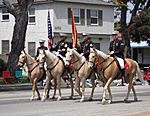
The Armed Forces Day Parade in Torrance, which was first produced in 1960, is the longest-running military parade sponsored by a city. It is held annually on Armed Forces Day, and runs down Torrance Boulevard. The parade features military vehicles, school bands, and prominent community members.
The Torrance Cultural Arts Center hosts cultural events year-round. In partnership with the City of Torrance, the Torrance Cultural Arts Foundation (TOCA) provides diverse cultural, educational and entertainment experiences. Additional performances are provided by the Torrance Performing Arts Consortium, including The Aerospace Players, Torrance Art Museum, Los Cancioneros Master Chorale, South Bay Ballet, South Bay Conservatory, and The Torrance Symphony.
In the 2010 Rose Parade, City of Torrance's entry won the top Lathrop K. Leishman trophy for its Garden of Dreams float, judged as the "Most Beautiful Non-Commercial" float. In 2011, Torrance won the Tournament Volunteers' Trophy for best floral design of parade theme under 35 feet in length. In 2012, the city's entry won the Governor's Trophy for best depiction of life in California. In 2015, an entry honoring Rose Parade Grand Marshal Louis Zamperini won the Theme trophy for excellence in presenting parade theme. In 2016, the City of Torrance float won the Princess trophy for most beautiful float 35 feet and under.
Historic landmarks
These Torrance landmarks are on the National Register of Historic Places:
- Main Building (Torrance High School) – Mediterranean Revival architecture, 1917 and 1921
- Original Science Building – Current Home Economics Building (Torrance High School)
- Auditorium (Torrance High School) – Streamline Moderne, 1938
- Torrance Elementary School – Current High School Annex – Mediterranean Revival
- Pacific Electric Railroad Bridge – designed by Irving Gill, 1913
Parks and recreation
City parks
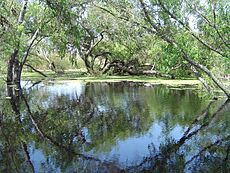
The Torrance City Parks Department directs and maintains the thirty Torrance City Parks. They include:
- Wilson Park – the 44 acres (0.18 km2) park has picnic and sports facilities, including a gymnasium, skatepark, and roller-hockey rink. Wilson Park also hosts the Torrance Farmers Market.
- The Southern California Live Steamers Miniature Railroad is located at the Southeast corner of Charles H. Wilson Park. Free train rides on actual miniature live steam trains are given on the first Sunday and third Saturday of each month and the 4th of July. SCLS was one of the first live steam clubs in California started in 1946 with original members like Walt Disney, Olie Johnston and Ward Kimball all of Disney fame. The club moved to Torrance in 1986 after leaving the Lomita Railway Museum property.
- Madrona Marsh Wildlife Preserve & Nature Center – a rare Southern California wetlands habitat with higher Coastal sage community native plants areas, wildlife and birdwatching, and a Nature center with natural gardens classes.
- Columbia Park – the large recreational urban regional park has picnic areas, field sports facilities, walking paths, jogging trails, and a competitive cross country running racecourse. The cherry blossom tree grove, part of Living Tree Dedication program, is in Columbia Park.
- Torrance Smart Gardening Center – Columbia Park features a Community Garden providing planting beds and "community" for residents. It is one of twelve county-operated Smart Gardening Centers around the region. Columbia Park additionally serves as home to the Home Garden Learning Center, and is a backyard composting demonstration center provided by Los Angeles County.
- Living Tribute Trees park program – The Torrance Parks Living Dedication Tree Program is coordinated and by the city, so that families, individuals, and groups can sponsor the planting of a new tree in the park to honor a person or commemorate an event with a living tribute Tree Dedication.
- Torrance Beach Park, and the beach along the Pacific Coast of Torrance, known as "RAT Beach".
- Marvin Braude Bike Trail (The Strand), a paved bicycle path that runs mostly along the Pacific Ocean shoreline in Los Angeles County, ends there.
Transportation
Zamperini Field (IATA: TOA ICAO: KTOA) is a general aviation airport. Commercial airlines service is within 15 minutes at Los Angeles International Airport and Long Beach Airport.
Highways and freeways in the region include I-110, I-405, SR 91, SR 107, and SR 1. The city is served by Torrance Transit, LACMTA Metro bus, and LADOT services.
Rail
Union Pacific currently operates what is left of the Pacific Electric's San Pedro via Gardena Line and Torrance Loop Line both built in 1911 (passenger service was provided until 1940, afterwards only the Torrance shop train was operated for employees). The Pacific Electric Torrance Shops were completed in 1918 and closed in 1955 two years after all passenger service was taken over by Los Angeles Metropolitan Transit Authority. Freight operations were taken over by PE's parent company, Southern Pacific, in 1965. SP was merged into UP in 1996.
The Los Angeles County Metropolitan Transportation Authority (LA Metro) plans to complete the C Line Extension of their Metro Rail system from Redondo Beach sometime between 2030 and 2033, though there are plans to accelerate the project as part of the Twenty-eight by '28 initiative so it can be done by the 2028 Olympics.
Freight to Torrance is served by BNSF and Union Pacific. BNSF operates on the former Atchison, Topeka & Santa Fe Railway Harbor Subdivision line originally built in the 1920s. AT&SF was merged with Burlington Northern in 1996 to form BNSF.
Proposed metro expansion
There have been proposals to expand the LA Metro to Torrance, but these proposals have faced opposition by Torrance politicians. In 2023, members of the Torrance City Council, Aurelio Mattucci and Jon Kaji, sought to block the expansion, arguing that the Metro would bring crime and homelessness to Torrance.
Education
Primary and secondary schools
Public schools
Torrance Unified School District (TUSD) was established in 1947 and unified in 1948. The district comprises the City of Torrance, bordered by the Palos Verdes Peninsula on the south, the cities of Redondo Beach and Gardena on the north, the City of Los Angeles (Harbor Gateway) on the east and the Pacific Ocean on the west. The district's jurisdiction covers approximately 21 square miles (54 km2), and it operates 17 elementary schools, eight middle schools, five high schools (one of which is a continuation school), three adult education centers, and a child development center.
The Torrance Unified School District's five high schools are:
- Torrance High School
- North High School
- South High School
- West High School
- Kurt Shery High School (continuation)
The Torrance Unified School District's eight middle schools are:
- Calle Mayor Middle School
- Casimir Middle School
- Bert Lynn Middle School
- J.H. Hull Middle School
- Jefferson Middle School
- Madrona Middle School
- Philip Magruder Middle School
- Richardson Middle School
The Torrance Unified School District's 17 elementary schools are:
- Hickory Elementary School
- John Adams Elementary School
- Torrance Elementary School
- Howard Wood Elementary School
- Anza Elementary School
- Arlington Elementary School
- Arnold Elementary School
- Carr Elementary School
- Yukon Elementary School
- Walteria Elementary School
- Riviera Elementary School
- Towers Elementary School
- Fern Elementary School
- Edison Elementary School
- Lincoln Elementary School
- Seaside Elementary School
- Victor Elementary School
Area districts have created the Southern California Regional Occupational Center (SCROC) to teach technical classes to their students and to local adults. TUSD is a participant feeder district of the California Academy of Mathematics and Science or CAMS, a mathematics and science magnet high school, administered by the Long Beach Unified School District.
Private schools
Torrance also has several private schools. Catholic schools under the Roman Catholic Archdiocese of Los Angeles include Bishop Montgomery High School, Nativity Catholic School, St James Catholic School and St Catherine Laboure Catholic School. Protestant private schools include Ascension Lutheran School and First Lutheran School.
In 1980 the Lycée Français de Los Angeles bought the 6.2-acre (2.5 ha) former Parkway School property, located in the Hollywood Riviera section of Torrance, from TUSD. This property became the Lycee's Torrance campus, and as of February 1990 the campus had 100 students. In November 1989 the Lycee sold the property for $2.65 million to Manhattan Holding Co. and scheduled to transfer the students to its West Los Angeles campuses. As of February 1990 neighbors of the campus site were asking the City of Torrance to not modify the zoning of this property. The Lycee stated that the campus closed due to low enrollment.
At one time, Coast Christian Schools (now Valor Christian Academy) maintained a high school campus in Torrance.
Colleges and universities
Torrance is in the El Camino Community College District. The campus El Camino College is mostly outside the city limits in unincorporated Alondra Park, while a portion is in the Torrance City limits. El Camino College was founded in 1947, and the campus covers 126 acres (0.51 km2). As of 2011, the college enrolls over 25,000 students each semester.
Miscellaneous education
In 1980, Asahi Gakuen, a weekend Japanese-language education institution, began renting space in South Torrance High School. The weekend school continues to use the high school for its Torrance Campus (トーランス校 Tōransu-kō). Asahi Gakuen has its administrative offices in Harbor Gateway, near Torrance.
Media
The Los Angeles Times is the metropolitan area's newspaper.
The Daily Breeze, a 70,000-circulation daily newspaper, is published in Torrance. It serves the South Bay cities of Los Angeles County. Its slogan is "LAX to LA Harbor". Herald Publications, media group started the Torrance Tribune, a community newspaper, which was started November 2010, it has a distribution of 15,000 newspapers to single-family homes and businesses in the City of Torrance.
Torrance CitiCABLE, shown on KNET 25.2, Spectrum 3, Frontier FiOS 31 is the government access channel. Programming includes news, sports, entertainment, information, public affairs, and city council meetings.
Notable people
- Albert Isen, first directly elected mayor
- Jason "Wee-Man" Acuña, TV host and actor
- Guillermo "Memo" Arzate, former professional soccer player
- Bela Bajaria, Netflix Chief Content Officer, Time 100 Most Influential People (2022); attended Torrance High
- Brian Bonsall, actor in Blank Check (1994 Disney film)
- Jonathan Bornstein (born 1984), soccer left back/midfielder (Chicago Fire FC and national team)
- John Butler, leader of the John Butler Trio
- Brandon Call, actor on Step by Step
- Larry Carlton, guitarist
- John Chiang, California State Controller
- Kraig Chiles, professional soccer player for the San Diego Sockers
- Roger Clinton, half-brother of President Bill Clinton
- Chase d'Arnaud, former Major League Baseball player
- Peter Daut, news anchor, KCBS-TV
- Rosemary Decamp, actress
- Chris Demaria, former MLB pitcher for the Royals and Brewers
- Bo Derek, actress
- Michael Dudikoff, actor
- Bobby East, NASCAR driver
- Ryan Ellis, NASCAR driver
- Whitney Engen, player for the United States women's national soccer team
- Carla Esparza, mixed martial artist; former UFC strawweight champion
- Stephanie Hsu, actress
- Kellen Goff, voice actor
- Ben Going, YouTube celebrity
- Tony Gonzalez, retired tight end for the Atlanta Falcons; 11-time Pro Bowl selection
- Rorion Gracie & Royce Gracie, mixed martial arts practitioners and UFC fighters
- Bart Johnson, retired MLB pitcher
- Parnelli Jones, USAC driver and his son, P. J. Jones, IRL driver
- Spike Jonze, director, producer, screenwriter and actor; part owner of skateboard company Girl Skateboards
- Fred Kendall, former MLB catcher and manager
- Jason Kendall, former MLB catcher
- Dave Kerman, drummer
- Chloe Kim, professional snowboarder, 2018 Winter Olympics gold medalist
- Kevin Kim, professional tennis player
- Jennifer Kita, Angel/Lil Angel of the Harajuku Girls
- Alix Klineman (born 1989), volleyball player
- Scott Kolden, actor
- Michelle Kwan, 5-time world champion figure skater and United States ambassador to Belize since 2022
- Dave LaRoche, former MLB pitcher; father of MLB players Adam LaRoche and Andy LaRoche
- Jennifer Lee (TOKiMONSTA), electronic music producer and DJ
- Ted Lieu, Democratic Party, U.S. Representative for California's 33rd congressional district
- Ted Lilly, retired MLB starting pitcher
- Jeremy Lin, professional basketball player
- Nancy Lopez, Hall of Fame professional golfer
- Joyce Manor, emo/punk band
- Brandon Manumaleuna, NFL tight end for the Chicago Bears
- Rami Malek, actor
- Antonio Margarito, Mexican-American professional boxer
- Francisco Mendoza, MLS player
- Alyson and Amanda Michalka (Aly & AJ), singers and actresses
- Justin Miller, MLB pitcher
- Ethan Moreau, former Los Angeles Kings hockey player
- Lisa Moretti, WWE's "Ivory"
- Chad Morton, NFL player
- Johnnie Morton, former NFL player
- Paul Moyer, television news broadcaster
- George Nakano, California politician
- Don Newcombe, former Los Angeles Dodgers pitcher; first winner of Rookie of the Year, MVP, and Cy Young awards
- Steve Nguyen, director, producer, and screenwriter
- Chuck Norris, karate expert and actor; raised in Torrance; opened his first dojo in Torrance
- Amy Okuda, actress
- Brian Ortega, mixed martial artist
- the Pedregon family, professional drag racers Frank Sr., Cruz, Frank Jr., and Tony
- Greg Popovich, founder and owner of Castle Rock Winery
- Jolene Purdy, actress, best known for role in Under the Dome as Dodee
- Daryl Sabara & Evan Sabara, actors (Spy Kids and Keeping Up with the Steins)
- Adán Sánchez, Mexican-American corrido singer
- Steve Sarkisian, Current head football coach at the University of Texas at Austin
- Sigi Schmid, LA Galaxy head coach
- Skip Schumaker, MLB outfielder
- Justin Shenkarow, actor
- Bud Smith, retired MLB player; threw no-hitter in his rookie season (2001)
- Snoop Dogg, rapper, actor; owns mansion in Hollywood Riviera neighborhood
- Joe Stevenson, mixed martial arts practitioner and UFC fighter
- Jack Stewart, soccer player, Carolina RailHawks in USL-1
- Royle Stillman, MLB outfielder
- Quentin Tarantino, filmmaker
- Ron Taylor, film and television actor, pro basketball player (ABA and Austrian League)
- Tyrone Taylor, center fielder for the New York Mets
- Deon Thompson, North Carolina Tar Heels basketball player
- Connor Tingley, artist
- Billy Traber, Major League Baseball pitcher
- Tiffany van Soest, kickboxer
- Janeene Vickers, 1992 Barcelona Olympics medalist
- Chauncey Washington, former NFL running back
- Glen Walker, NFL player
- J. Warner Wallace, homicide detective and Christian apologist
- David Wells, former MLB pitcher
- Paul Westphal, NBA player and former head coach
- Ryan Wheeler, MLB third baseman
- Denzel Whitaker, actor
- John White, CFL player
- Steven Wright, starting pitcher for Boston Red Sox
- Louis Zamperini, 1936 Olympic track star, World War II veteran, author, speaker; subject of Unbroken
- Latrice Royale, drag queen; best known for competing on the fourth season of RuPaul's Drag Race and the fourth season of RuPaul's Drag Race All Stars
Sister cities
In 1973, Torrance established a sister-city relationship with Kashiwa, Chiba, Japan, as part of the Sister Cities International program. Since then, citizens of Torrance have regularly engaged in cultural exchange with Kashiwa through the guidance of the Torrance Sister City Association, which facilitates a Japanese cultural festival, a yearly student exchange program, and contact between officials of the two cities. North High is the official sister high school of Kashiwa Municipal High. Torrance has also a sister-city relationship with Konya, Türkiye since 1958.
See also
 In Spanish: Torrance (California) para niños
In Spanish: Torrance (California) para niños




